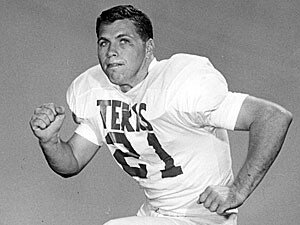08.29.2006 | Football
Bill Little commentary: He was always there
They buried Joe Dixon Tuesday, after a service of praise, prayers and tribute. The world, and particularly the community of Longhorns football from the 1960s, will never be the same.
In life and on the field, it seemed, Joe Dixon was always there.
Dixon, who was an all-Southwest Conference wingback and defensive back for the Longhorns in the era that spanned 1962 through 1964, had mowed his lawn and was cleaning golf balls in his garage when he slumped off his stool into another dimension. His wife of 41 years found him when she came home after a shopping expedition.
To say that those who knew Joe were stunned would be an understatement.
It's hard to imagine the world without him.
Because, Joe was always there.
Just last Wednesday, Joe and his friend and former teammate Clayton Lacy had driven to Austin just to have lunch with their coach, Darrell Royal. Joe was in great spirits as he visited Sheila Eveslage in the T-Association Office, talking about how excited he was about the upcoming season opener against North Texas. Joe was bringing his family, and coming to the Alumni meeting of the Longhorn Hall of Honor court.
Monday, Sheila recalled the many T-Association receptions -- from Dallas to Austin to Pasadena -- Joe had attended.
"He always came," she said. "I think he thought because we had gone to the trouble to have it, he owed it to us to come."
She remembered the joy prior to the National Championship Game in California, where Joe and his family visited as long as anyone would stay and celebrate the moment of the Horns in Pasadena. Joe knew the feeling of Mack Brown, his coaches and players, for he had been a part of one of the greatest eras of Texas Football.
From his sophomore season of 1962 through his senior year of 1964, Texas lost only two football games. Dixon was an important part of the 1963 team, excelling on defense in the secondary, and playing wingback. As the season of 1964 approached, he was even given a look at quarterback before earning all-SWC honors as a defensive back.
In a 10-6 victory in 1963 over a tough Rice team in the days when Jess Neely had the Owls competed for conference championships, Dixon intercepted two Rice passes in critical situations. Then, after Rice blocked a Texas field goal attempt, the Owls' John Sylvester scooped up the ball and was headed for a touchdown that could have shattered the dream of the Horns first National Championship.
But Dixon, who was the holder on the play, tackled Sylvester.
"Sylvester had nothing but grass between him and the Longhorns goal," said Royal after the game. "Joe made a great stop on him. It was the biggest play of the game."
Seconds later, Dixon intercepted a long Rice pass to end the Owl threat.
Nobody was surprised, because, it seemed, Joe was always there.
In 1962, in one of the most famous plays in Texas Football history, the Longhorns' were backed up to their own goal trying to hold off an Arkansas team that led, 3-0. Ranked No. 1 in the country, the rating and a lot of hopes were on the line when the Razorbacks' Danny Brabham hit the middle of the Texas line.
History -- and a famous photograph of the play -- tell the story of linebackers Pat Culpepper and Johnny Treadwell hitting Brabham. The freeze frame of the photograph shows only Brabham's crossed arms, with the ball flying out. What is missing is what happened next.
For it was Joe Dixon who grabbed the free ball. Had the Razorbacks recovered, it would have still been an Arkansas touchdown. But it wasn't.
Because Joe Dixon was there.
Alan Cannon, who is in charge of media relations at Texas A&M University, knew Joe when Cannon was coaching American Legion baseball in the Dallas area, and Joe's son, Jody, was playing on Cannon's team.
"He was always willing to do anything that would help," Cannon recalled. "He'd offer to rake the field or hit fungos. All he wanted to do was support."

